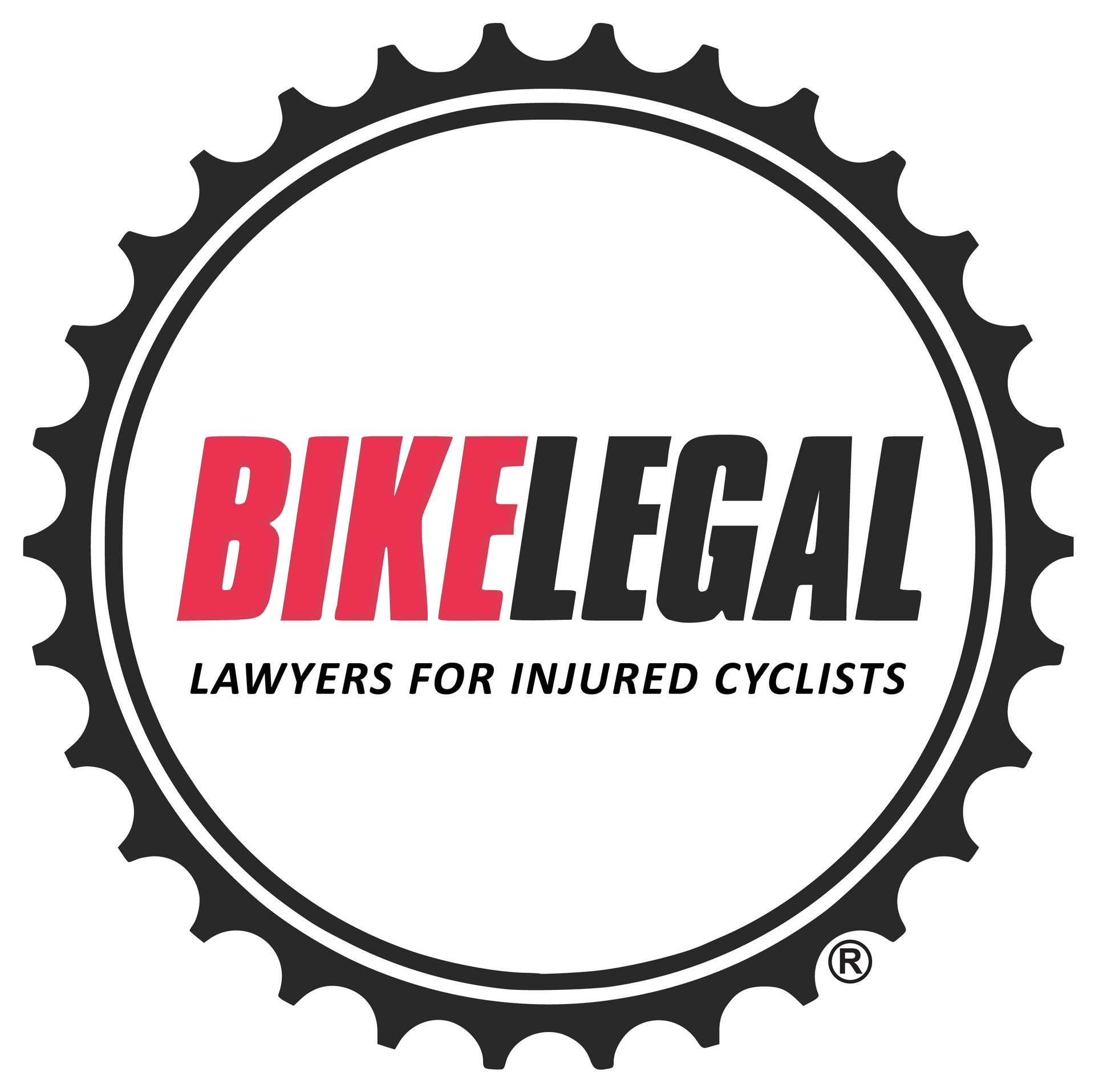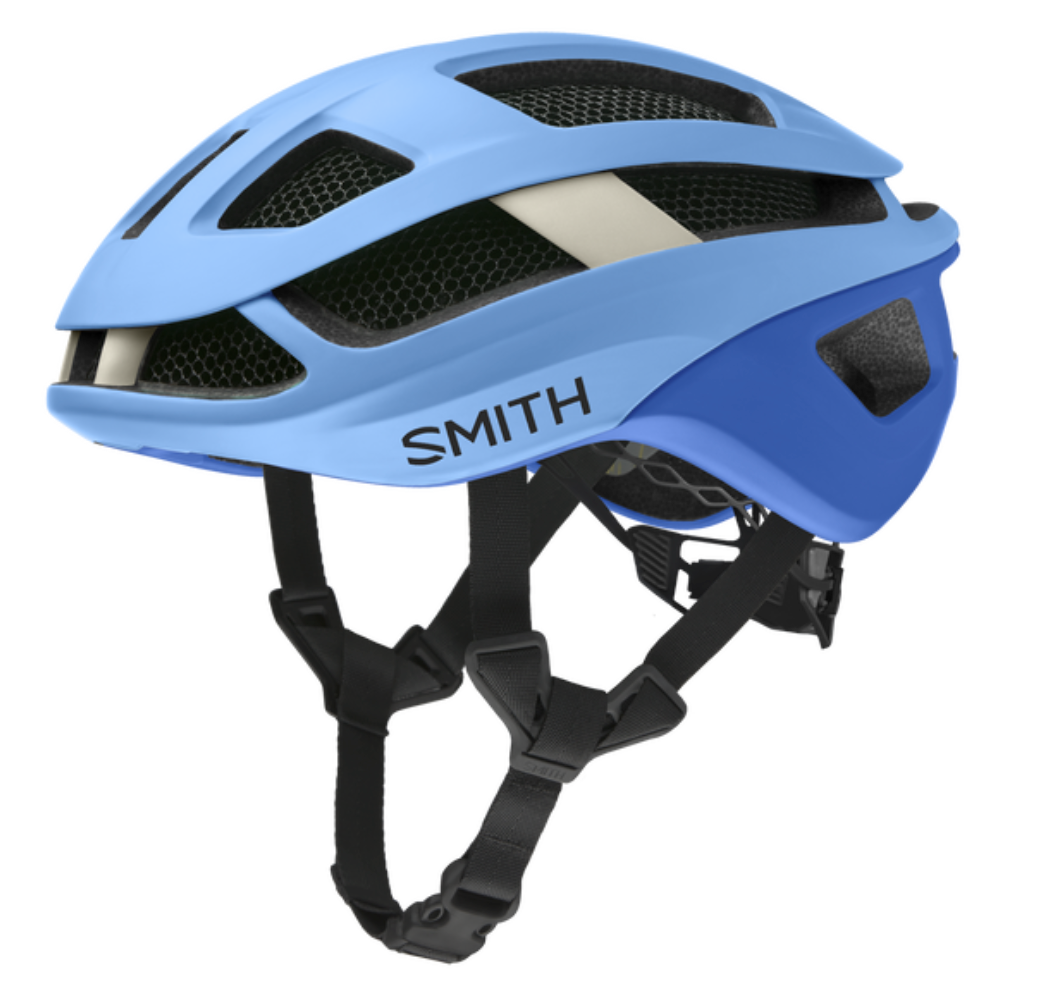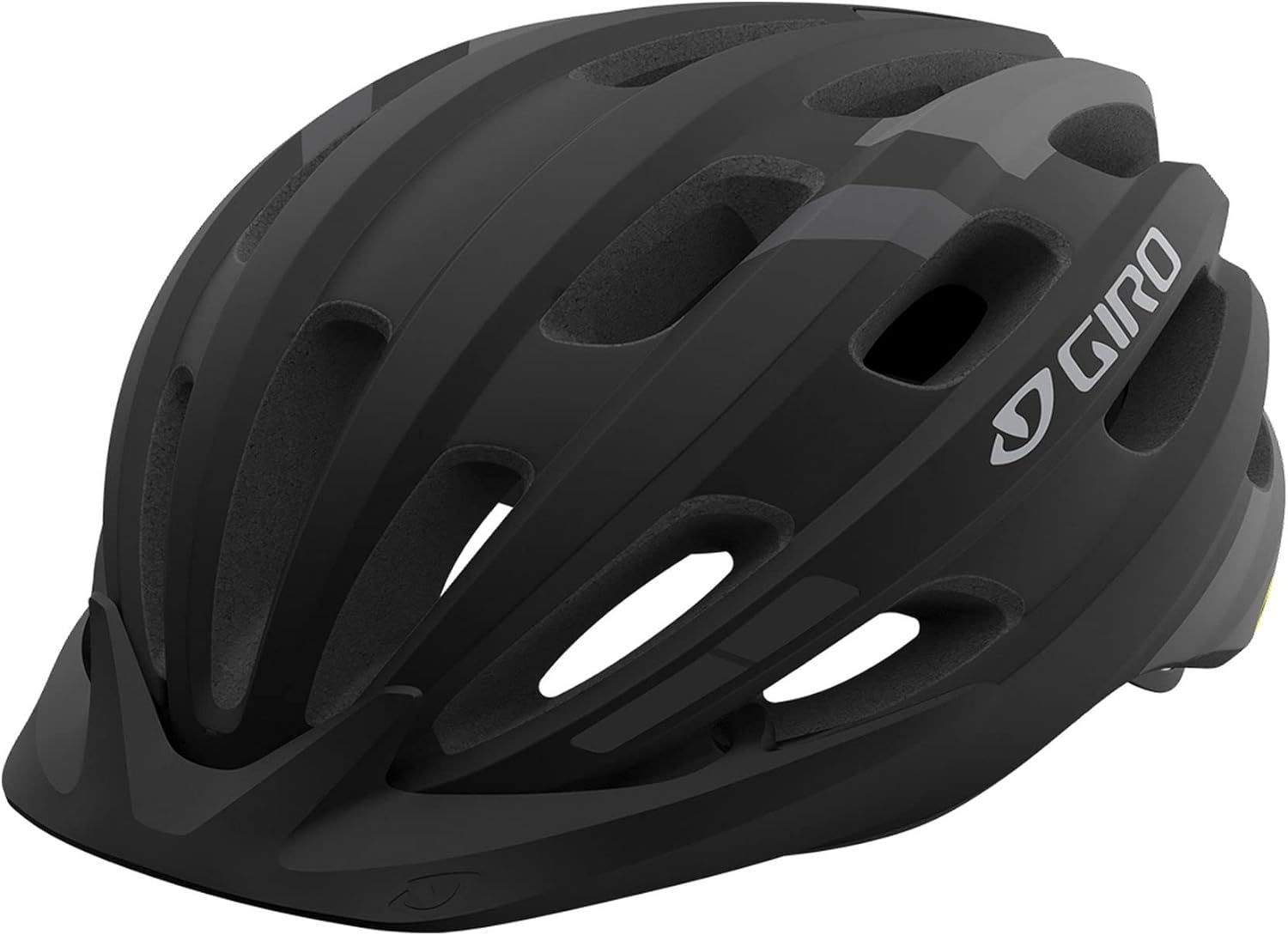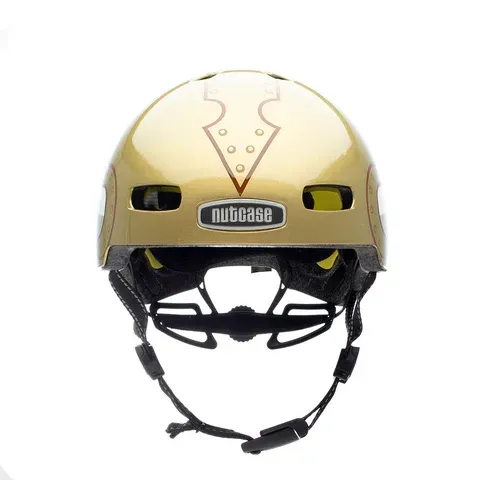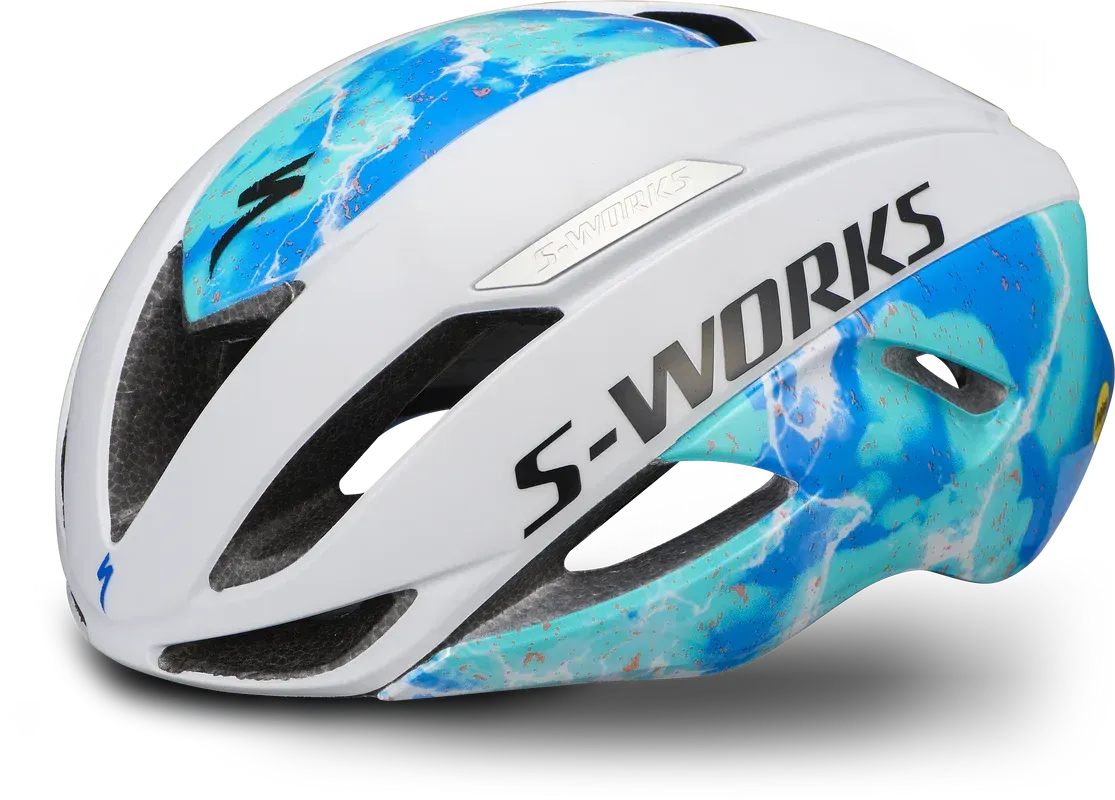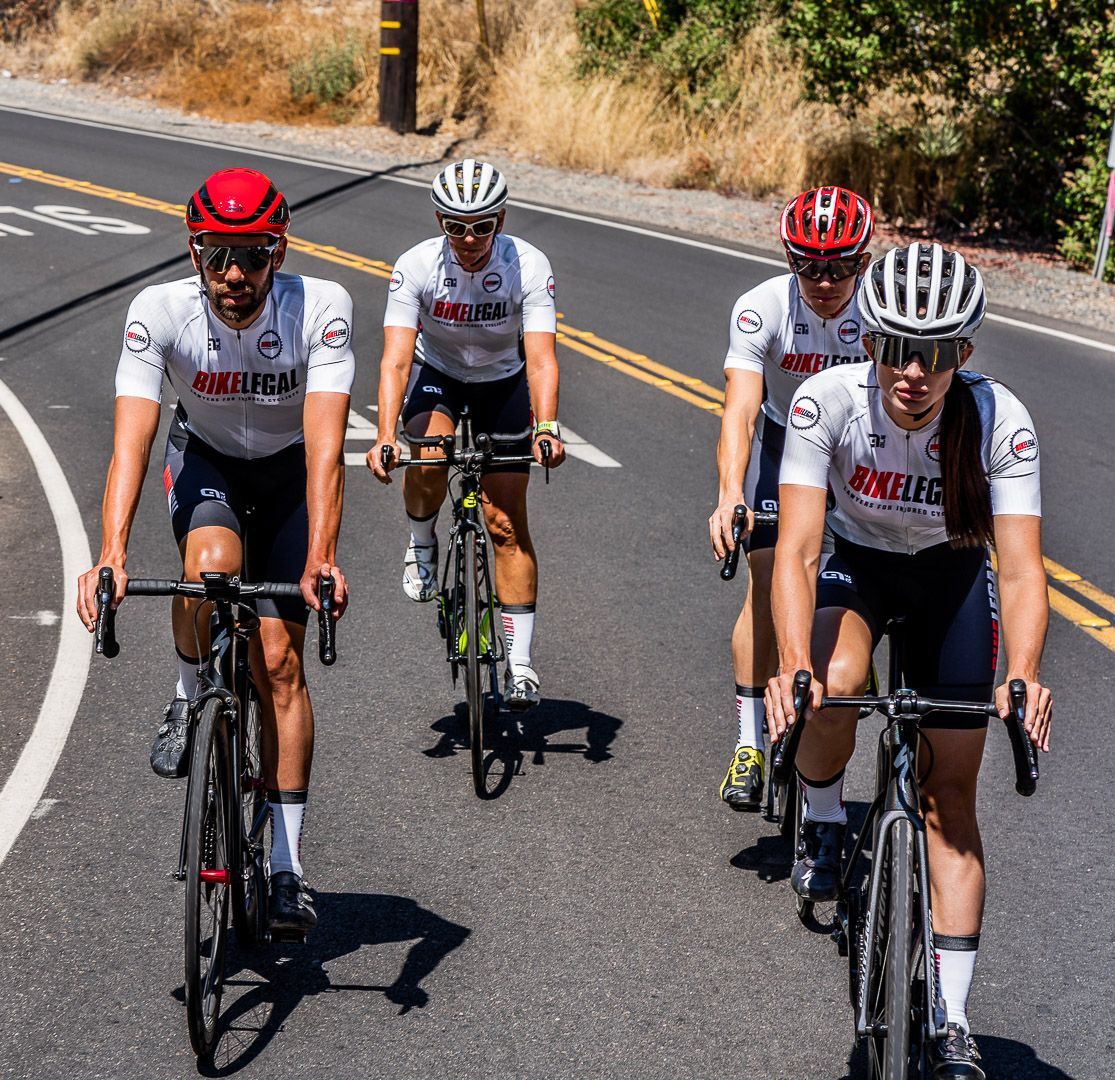(2024) The Ultimate Bicycle Helmet Guide for Cyclists
Follow us on
social media!
A properly selected bicycle helmet is your primary defense against head injuries, which account for 75% of annual cycling-related fatalities. With the right helmet, not only can you safeguard your skull, but you can also enjoy the ride with comfort, style, and compliance with local laws.
In this ultimate guide, we cover the crucial considerations for picking out a new helmet, explain how helmets work, when to replace them, and essential safety standards. Whether you’re new to cycling or a seasoned rider, this guide will help you make an informed decision to stay safe and confident on the road.
Key Topics:
- Why bicycle helmets are important and the statistics that support it
- Bicycle helmet laws
- Key considerations for selecting your perfect helmet
- 2024 bicycle helmet trends and innovations
- Insider reviews and top picks across categories
- Crucial features and specs that shouldn't be overlooked
- A side-by-side look at leading brands and what sets them apart
Why Are Bike Helmets Important?
Bicycle helmets are crucial for safeguarding cyclists from head injuries that can lead to severe consequences. Here’s why wearing a helmet is essential:
- Head Protection: Helmets serve as a vital barrier, reducing the impact of collisions and falls. Studies have shown that wearing a helmet reduces the risk of head injuries by 48% and serious head injuries by 60%.
- Traumatic Brain Injury Prevention: Traumatic brain injuries (TBIs) can have long-term consequences, and helmets help minimize these risks. Cyclists wearing helmets have a 53% lower risk of sustaining TBIs.
- Facial Injury Reduction: Helmets also protect the face, reducing the chances of facial fractures by 31%.
- Fatality Reduction: Cyclists who wear helmets are less likely to suffer fatal injuries, with a 44% reduction in mortality rates.
- Legal Compliance: In many regions, helmet use is mandated by law, underscoring its recognized importance for personal safety.
Statistics of Bicycle Accident Injuries and Fatalities Based on Helmet Usage

- Overall Injury Reduction National Library of Medicine Statistics:
- Wearing a helmet reduces head injuries by 48%.
- Serious head injuries are decreased by 60%.
- Traumatic brain injuries (TBIs) are reduced by 53%.
- Cyclist fatalities or severe injuries decline by 34%.
- Of 6,267 cyclists studied, only 25.1% wore helmets.
- Helmet wearers had 51% lower odds of severe TBIs and 44% reduced mortality.
- Helmet use reduced facial fracture odds by 31%.
- One-third of non-fatal cyclist injuries are head-related.
- Each year, emergency rooms treat over 80,000 cycling-related head injuries, most of which are brain injuries (Consumer Product Safety Commission).
- Among 76,032 cyclists with head/neck injuries, only 22% wore helmets.
- Helmet wearers had significantly lower injury severity, shorter hospital stays, and reduced mortality.
- Men wore helmets less frequently than women (21% vs. 28%).
- Men experienced more severe injuries, longer hospital stays, and higher mortality compared to women.
To learn more about the real dangers of choosing to ride without a bicycle helmet, read our article Bike Accidents Without Helmets.
Why Do People Not Wear Helmets?
Despite the clear safety benefits of bicycle helmets, some individuals choose not to wear them due to a mix of personal preferences and broader societal concerns. On an individual level, people cite practical issues like helmets being uncomfortable, difficult to transport, and interfering with hairstyles. There's also a perception that helmets look "uncool," especially among younger cyclists.
Bicycle Helmet Laws and Arguments Against Them
Bicycle helmet laws vary significantly worldwide. Some countries have mandatory helmet regulations, while others opt for voluntary compliance.
Global Overview of Bicycle Helmet Regulations and Laws:
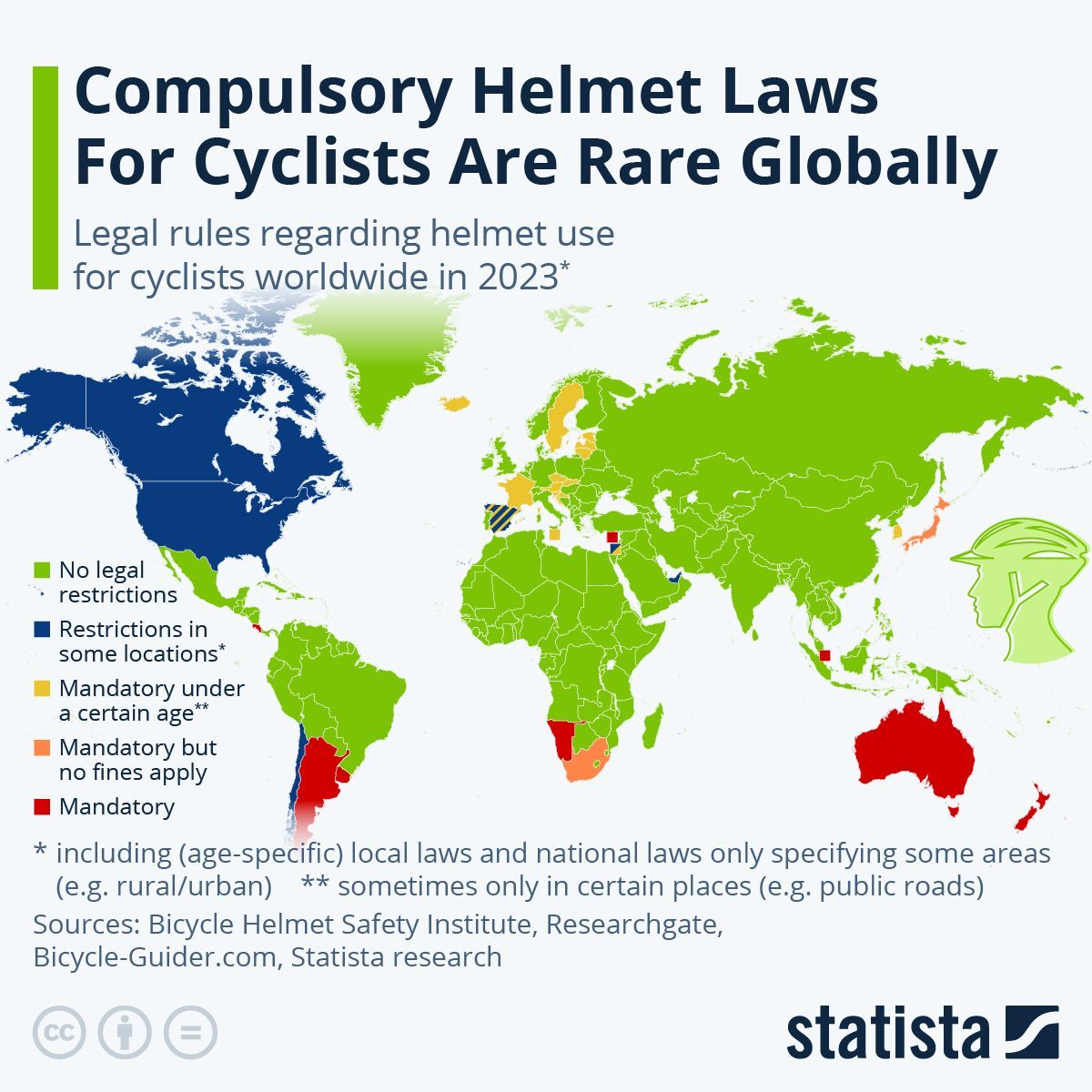
Bicycle Helmet Laws in The United States
In the United States, bicycle helmet laws are largely managed at the state or local level. While there is no federal mandate, 22 states and the District of Columbia have statewide laws requiring helmets for certain age groups, primarily children under 18.
More than 200 local ordinances also exist across the country. A small number of jurisdictions have all-ages laws, but these are not widespread. Additionally, riders of electric bikes are required to wear helmets in some states.
To learn more, read our in-depth article covering The Bicycle Helmet Law Debate: Why the U.S. Lacks a National Mandate.
Countries with Mandatory Bicycle Helmet Laws
Australia led the charge globally by introducing compulsory helmet laws between 1990 and 1992. Other nations that have since implemented mandatory bicycle helmet use include New Zealand, Namibia, Argentina, Costa Rica, Uruguay, Cyprus, and Singapore. Japan joined this group on April 1, 2023, making helmet use compulsory for all cyclists, though there are no fines for non-compliance.
This approach aims to encourage helmet use without punitive measures, which could disproportionately affect certain socioeconomic groups. Israel and South Africa also have helmet mandates without fines due to enforcement challenges or public opposition.
Countries Without Strict Bicycle Helmet Laws
In most European nations, helmets are not required for adults. However, in countries like the Netherlands, Denmark, and Germany, where biking culture is robust and infrastructure is well-developed, cycling is considered relatively safe without compulsory helmet use. Many European countries require helmets for minors or younger children.
Similarly, Spain mandates helmet use for all ages outside cities, except on uphill climbs. In Canada, several provinces enforce helmet laws for children. The United Arab Emirates has regional laws requiring helmets, particularly in Dubai.
Despite varying levels of enforcement, many regions are balancing helmet safety with the realities of local cycling habits.
Arguments Against Mandatory Bicycle Helmet Laws
Critics of mandatory helmet laws point out the unintended consequences of such regulations. Some studies suggest that enforcing mandatory helmet use can lead to fewer people cycling, potentially reducing the health benefits of regular exercise. There's also concern that fines for non-compliance disproportionately impact marginalized communities with less access to resources and information.
Moreover, advocates for better cycling infrastructure argue that a network of protected bike lanes, driver awareness, and creating a culture of mutual respect between drivers and cyclists are more effective strategies for reducing cycling-related injuries than helmet mandates alone. They believe that increasing the number of cyclists on the road will foster safer traffic conditions overall.
While helmets provide essential personal protection, the larger conversation surrounding cycling safety involves a more comprehensive approach that emphasizes inclusivity, infrastructure, and awareness.
Essential Considerations When Choosing a Bicycle Helmet
When selecting a new biking helmet, consider the following important factors:
What Type of Bicycle Helmet Do You Need?
- Road Cycling: Look for lightweight, aerodynamic helmets with ample ventilation. Road biking helmets typically lack visors to provide a clear forward view.
- Mountain Biking: Helmets with extra rear head coverage and visors to protect against debris are ideal. They often come with chin bars for downhill mountain biking.
- Commuting: Opt for helmets with integrated lights and reflective materials for visibility. Consider a casual, comfortable design for daily use.
- Kids' Helmets: Ensure a proper fit and look for adjustable features to accommodate growth.
Bicycle Helmet Safety Certifications:
Look for a CPSC sticker inside U.S.-market helmets. Additional standards like ASTM F1447 or Snell B-95 offer enhanced safety criteria but are less common. Always prioritize a secure fit and proper certification.
Helmet Fit and Comfort:
Your helmet should sit level on your head, cover as much of your skull as possible, and remain secure even after multiple impacts. Adjust straps and fitting pads until the helmet cannot be removed through twisting or pulling. The strap should remain snug yet comfortable. Look for easy-to-adjust straps with secure locking systems that stay put during rides.
Bicycle Helmet Profile:
Choose a cycling helmet with a rounded, compact profile that eliminates rear points.
Impact Protection Technology:
Look for helmets featuring advanced impact protection systems, such as MIPS (Multi-Directional Impact Protection System) or similar technologies. These systems help reduce rotational forces that may contribute to concussions.
Ventilation and Visors:
Adequate helmet ventilation is essential, especially for longer rides in hot climates. Check for the placement and size of vents to ensure sufficient airflow. However, beware of helmets with excessive vents or rigid visors, as they could compromise safety.
Bicycle Helmet Technology Features:
Consider features like integrated lights, cameras, or smart helmet functions like impact sensors and communication systems.
Customization and Adjustability:
Look for adjustable straps, removable padding, or other features that can be tailored to your specific needs. Individuals with unusual head shapes or long hair should consider helmets with extra fitting pads or ponytail ports. Bald riders may prefer helmets without large top vents to avoid sun damage to the scalp.
By carefully considering these factors, you can find a bicycle helmet that offers the best combination of safety, comfort, and practicality for your cycling needs.
2024 Bicycle Helmet Design Trends and Innovations
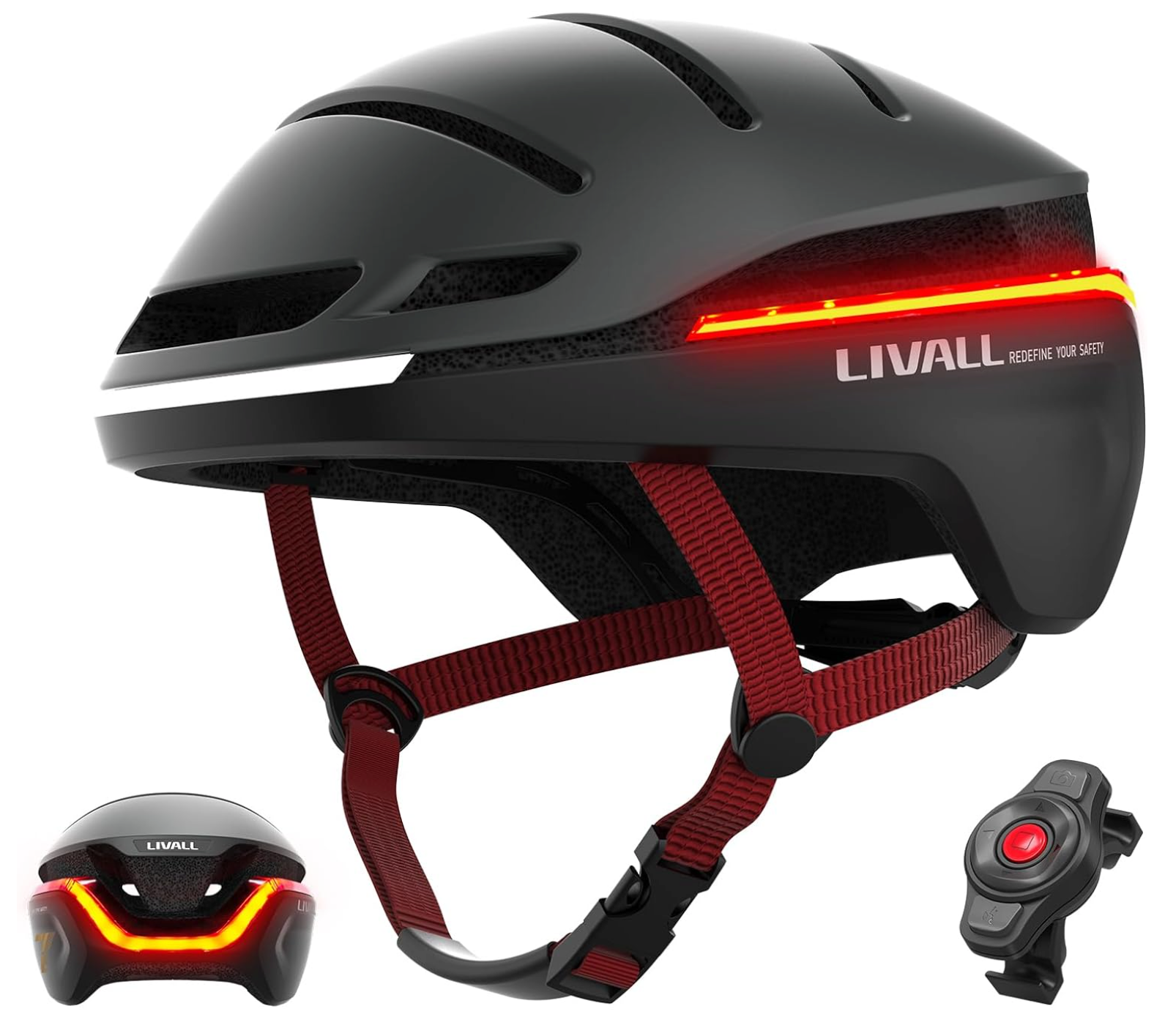
Bicycle helmets have seen significant evolution in 2024, driven by new technologies and growing consumer demands for better protection, customization, and connectivity. Here are the key trends shaping helmet design this year:
- Rounded, Compact Profiles: The market has largely embraced rounded and compact designs, eliminating rear points to reduce snagging hazards during crashes. While no groundbreaking advances in ventilation or comfort have surfaced, the improved profile prioritizes safety.
- Concussion Protection: With concussion protection at the forefront, research and testing by institutions like Virginia Tech aim to rank helmets based on their ability to prevent concussions. Though their methodology has received some scrutiny, the push for better low-impact performance is evident, and helmets with multi-directional impact protection systems (MIPS) remain popular. Consumer Reports has also tested helmets for rotational force.
- 3D Printing Customization: Companies like KAV and HEXR are revolutionizing bike helmet fit by using 3D printing. KAV offers custom-fitted helmets designed through individual head measurements, while HEXR provides individualized helmets using head scans. These 3D-printed helmets enhance comfort and potential safety.
- Rotational Management Systems: Technologies like MIPS, elastomer pads, and innovative liner materials are prevalent. Brands like Bontrager use WaveCel, a collapsible plastic mesh that manages rotational energy. Other companies like 6D, Kali, and Leatt are offering alternative solutions.
- Smart Helmets: Smart helmets have advanced features like integrated cameras, navigation, intercoms, and impact sensors. Brands like Airius, Livall, and POC lead this sector. However, studies suggest caution around electromagnetic exposure.
- Increased Protection: Helmets with additional coverage for the ears, rear, and sides offer improved safety for trail riding and enduro cycling. Some models, like Fox's Dropframe Pro, provide protection below the ears while meeting downhill safety standards.
- Folding and E-bike Helmets: Folding designs cater to shared bicycle programs, while helmets meeting the new European NTA 8776 e-bike standard offer increased rear coverage.
- Color Trends and Customization: Bold new colors and accessories allow cyclists to personalize their helmets while staying safe on the road.
These design trends in 2024 reflect a shared commitment to improved safety, style, and functionality, ensuring that riders have access to helmets tailored to their specific needs.
Bicycle Helmets' Sizing Guide
Getting the right fit for your bike helmet is paramount, not just for comfort but for ensuring it can provide maximum protection during a ride. Here's how to measure your head and match it with the right bicycle helmet size:
Step-by-Step Measuring Guide:
- Find Your Tool: Grab a flexible measuring tape. If you don't have one, a piece of string and a ruler will do the trick.
- Measure Your Head: Wrap the tape or string around the widest part of your head. This is usually about an inch above your eyebrows and ears, circling around the back of your skull. Make sure the tape is level and snug, not tight.
- Record Your Measurement: Note the measurement where the tape overlaps. If you're using string, lay it flat next to a ruler to get your size.
- Consult a Bicycle Helmet Size Chart: Once you have your head circumference, it's time to find your size on a helmet sizing chart.
Understanding Helmet Size Charts:
A typical bike helmet size chart might look something like this:
- XX-Small: 51-52 cm
- X-Small: 53-54 cm
- Small: 55-56 cm
- Medium: 57-58 cm
- Large: 59-60 cm
- X-Large: 61-62 cm
- XX-Large: 63-64 cm
If your measurement falls between two sizes, opt for the smaller size for a snug fit or the larger size for a looser fit. Remember, many helmets have adjustable fit systems for fine-tuning.
Pro Tips for a Perfect Fit:
- Wear Your Helmet Correctly: The helmet should sit level on your head, covering most of your forehead without tilting backward or forward.
- Adjust the Fit System: Use the helmet's rear dial (if available) to tighten or loosen the fit around your head.
- Check the Strap Dividers: They should sit below your earlobes and lie flat against your face.
- Secure the Chin Strap: The strap should be snug under your chin, allowing you to breathe comfortably but without too much slack.
Types of Bike Helmets
Each helmet type is engineered with specific features and designs to meet the unique demands of different cycling disciplines. Let's break down the main types:
Road Bike Helmets:
- Design: Sleek and lightweight, designed for speed and efficiency. Aerodynamics is key, so they often have a smooth, rounded shape to minimize air resistance.
- Ventilation: Packed with ample vents to ensure maximum airflow, keeping you cool during long rides on hot days.
- Features: Typically lack visors to maintain a clear field of vision in a forward-leaning position.
Mountain Bike Helmets:
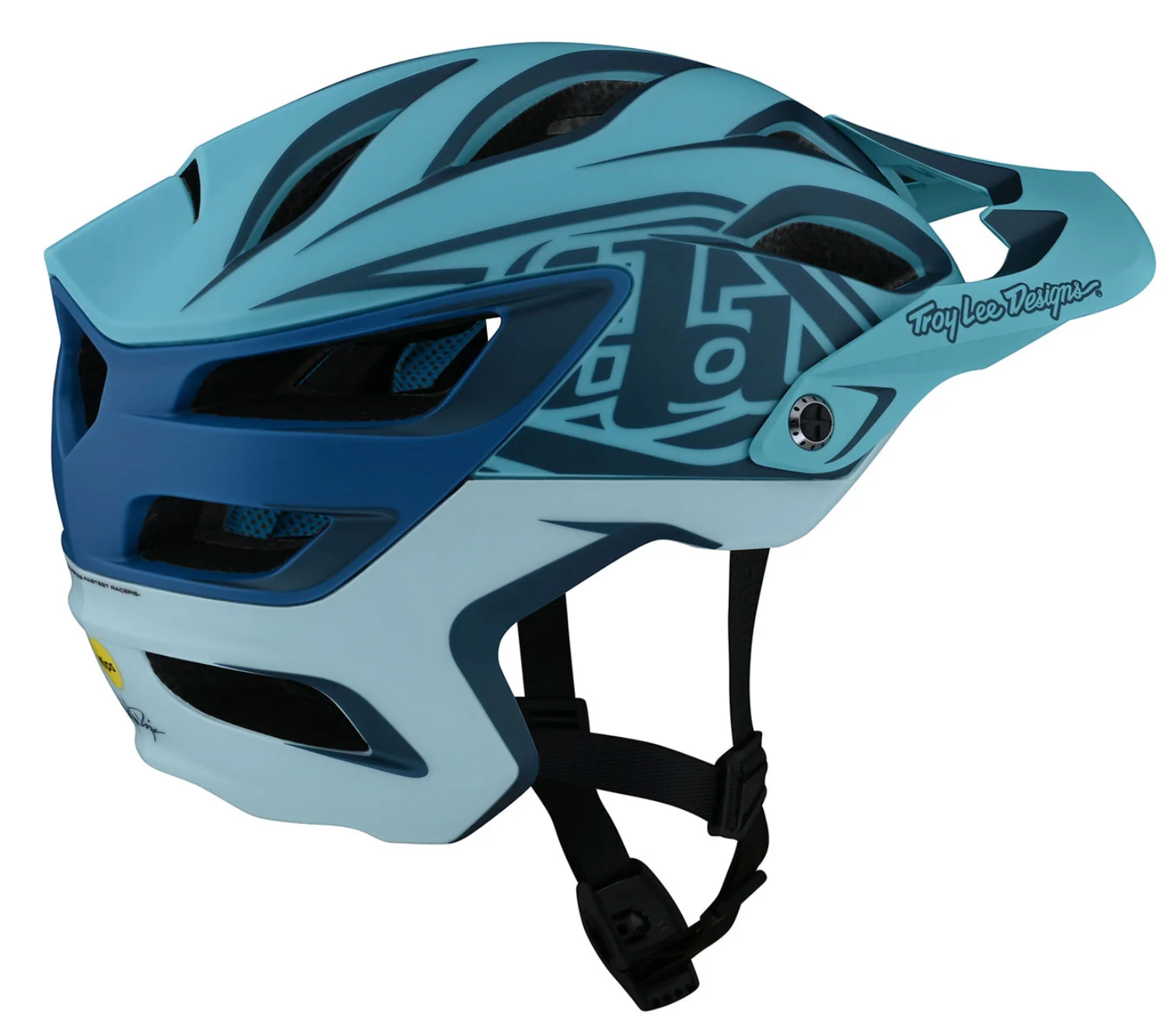
- Design: Built for rugged terrain, these helmets offer enhanced rear head coverage to protect against falls that are more common on trails.
- Ventilation: Well-ventilated but with slightly fewer openings than road helmets to strike a balance between airflow and protection.
- Features: Often come with visors to shield eyes from sun, rain, and debris. Some models offer additional protection technologies like MIPS for rotational forces during impacts.
Commuter Helmets:
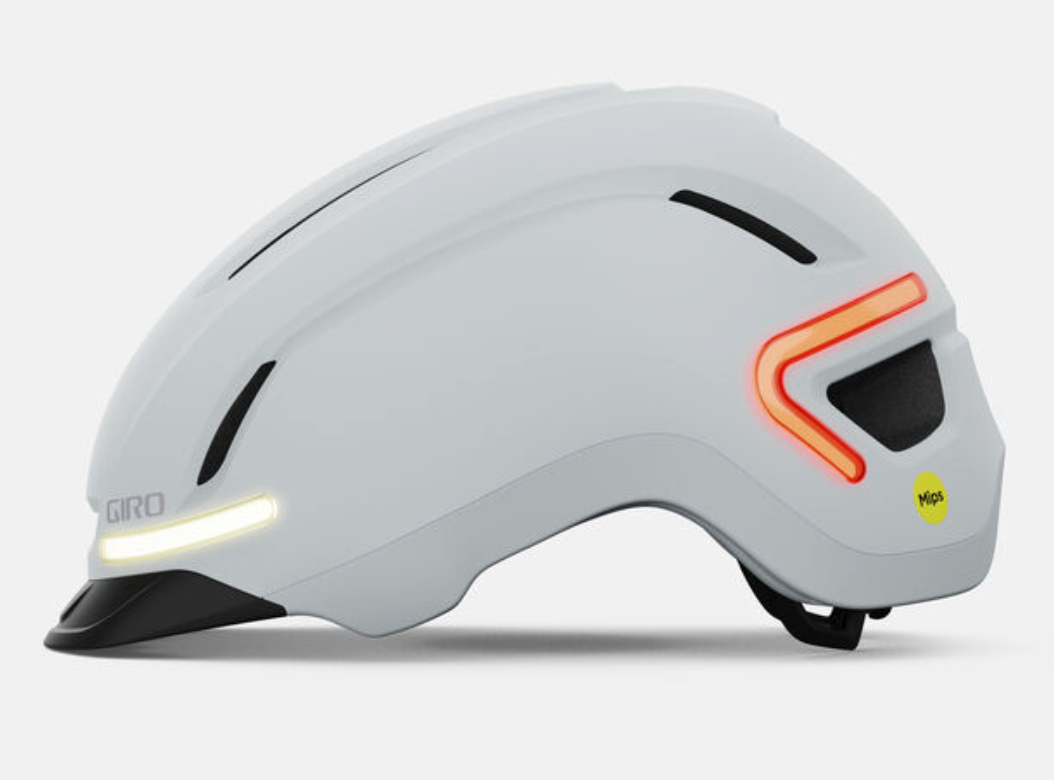
- Design: Focus on comfort and practicality for daily rides, with a more casual, sometimes urban-inspired style.
- Ventilation: Adequate ventilation for moderate speeds, with a focus on comfort over long periods.
- Features: These may include integrated lights or reflective materials for increased visibility in urban settings.
Helmets for Kids:
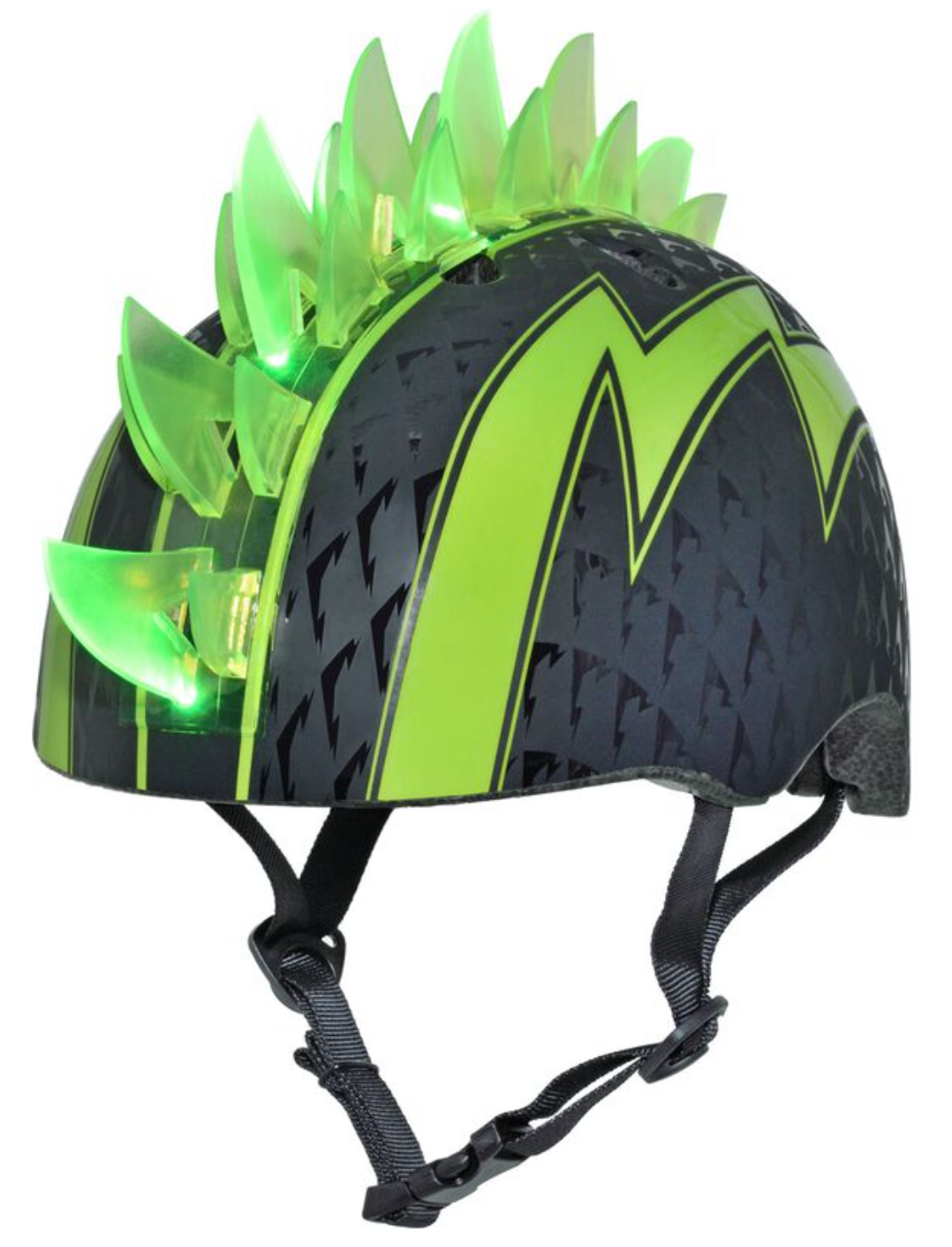
- Design: Safety is paramount, but so is a design that appeals to children to encourage consistent wear. Kids love picking out bright and fun bike helmets!
- Ventilation: Designed to keep young riders cool and comfortable.
- Features: Typically include an easily adjustable fit system to accommodate growing kids and a pinch-guard buckle to prevent discomfort while securing the helmet. Some even come with lights.
Comparison of Helmet Brands and Models
For a more detailed and specific comparison of helmet categories, let's select a well-known and widely available helmet model for each category (from beginners to pros). Here are the chosen helmets for comparison:
1) Entry-Level Road Helmet: Giro Register
- Strengths: The Giro Register combines style, comfort, and safety at an accessible price point. It features the Roc Loc Sport fit system for easy adjustments and 22 vents for optimal airflow.
- Weaknesses: While it offers great value, it lacks some of the advanced protection features found in higher-end models, such as MIPS.
- Customer Feedback:
"Comfortable, easy to dial in the correct size after putting on. It's lightweight and relatively cool in ventilation. Feels and looks like a quality helmet. I'm happy with the purchase."
"The helmet is comfortable and can be adjusted to accommodate head size. Only criticism is straps lack lateral adjustment however buckle can be adjusted to proper length."
2) High-End Road Helmet: Specialized S-Works Prevail II
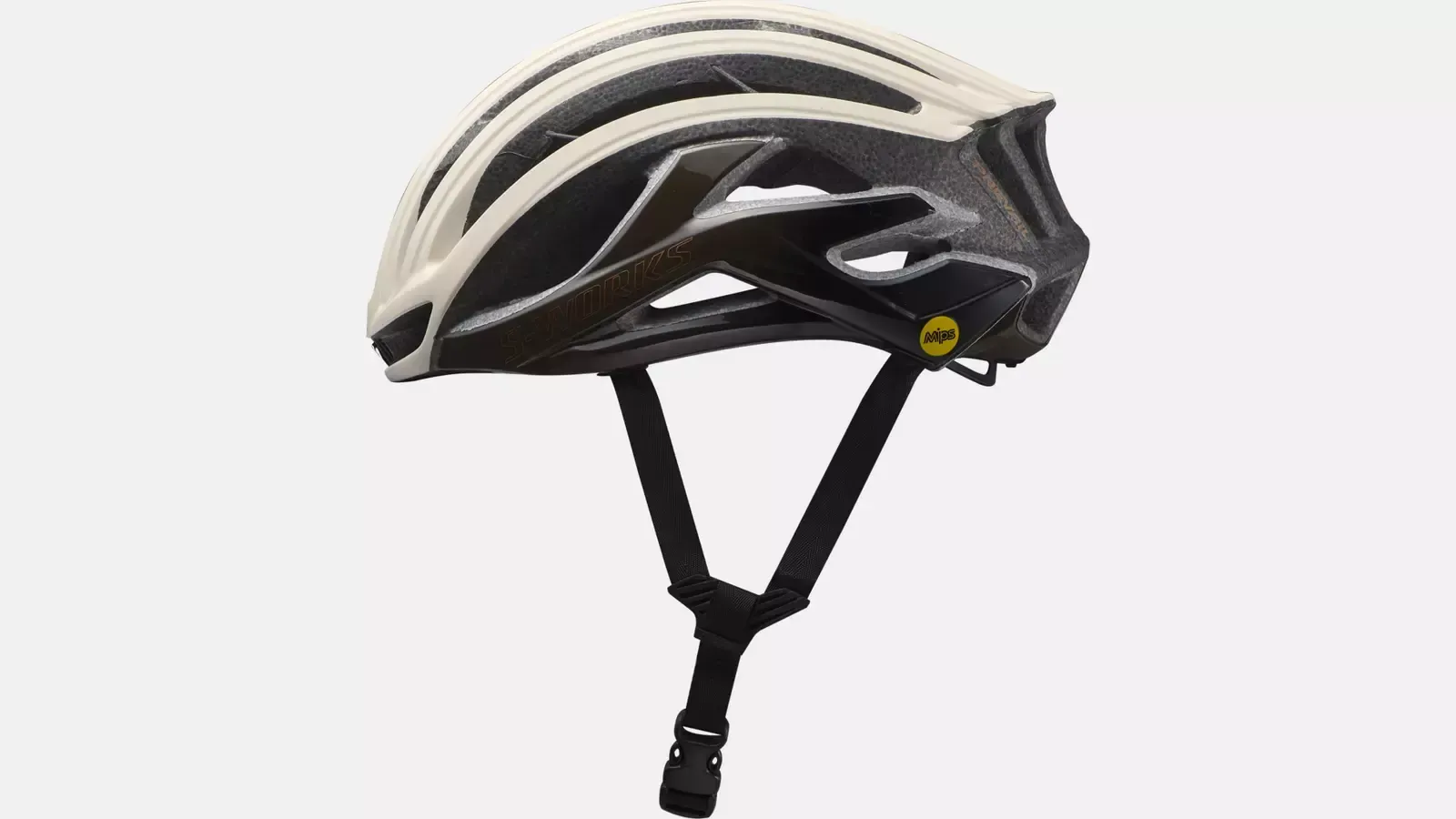
- Strengths: Specialized S-Works is a top choice for serious cyclists, featuring advanced aerodynamics, MIPS SL—a lighter version of MIPS for less rotational force—and exceptional ventilation. It's known for its ultra-lightweight construction.
- Weaknesses: The high-end features and brand prestige come with a premium price, which might be prohibitive for casual riders.
- Customer Feedback:
"Had the worst crash of my life 6 weeks ago! fractured vertebrae in neck, compressed 3 vertebrae in back, broke 5 ribs with 2 displaced and collarbone took a plate with 12 screws and bone graft to put back together. Helmet was broken and i ended up with a small bruise and tiny cut on head where helmet hit the ground. Definitely will get another one of these helmets before i'm able to get back on bike."
"I came on here to buy second one of these helmets. I'm currently in hospital after surgery on my arm. I crashed, the helmet broke, but it did its job. The only part of me that's not cut, broken or bruised is my head! This helmet simply works."
3) Mountain Bike Helmet: Troy Lee Designs A2 MIPS
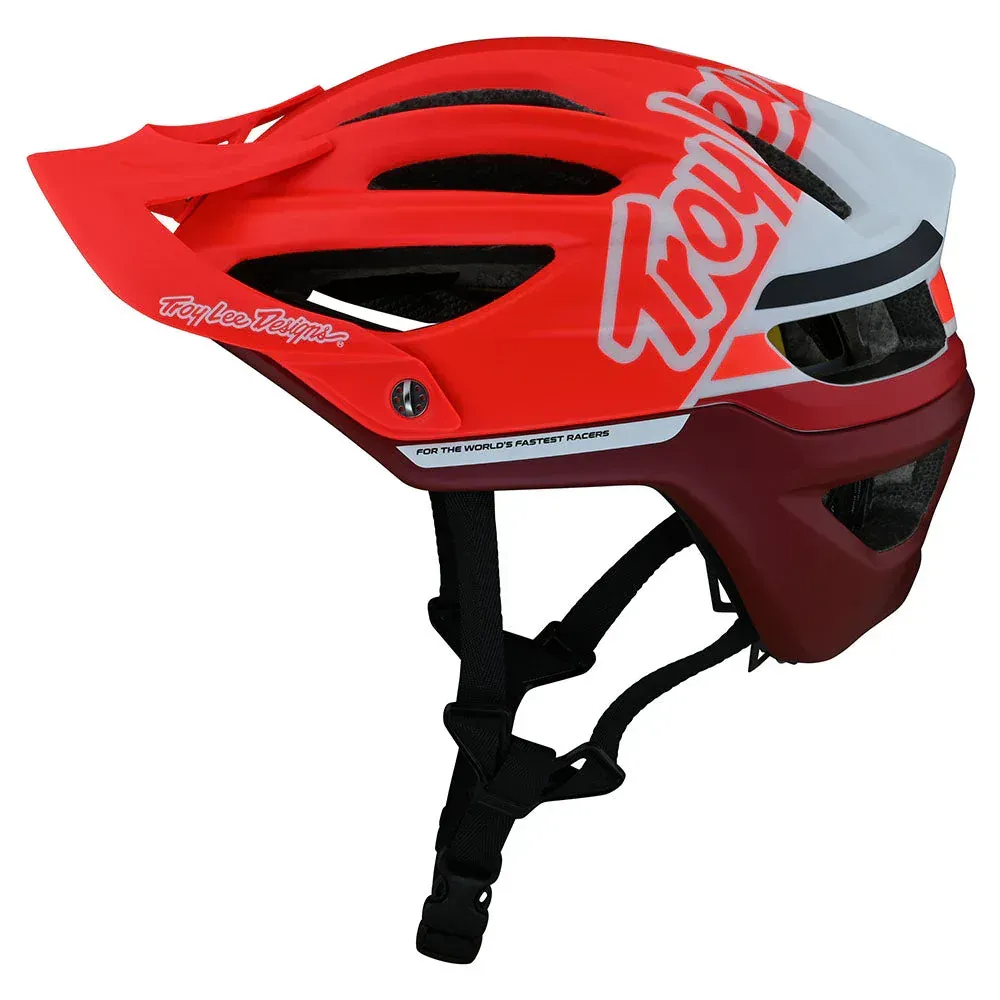
- Strengths: Designed for the trails, the Troy Lee A2 offers extended coverage, an adjustable visor, and MIPS for added safety. It's well-ventilated and features a dual-density EPS foam for better impact protection.
- Weaknesses: Some users find the fit slightly bulkier compared to road helmets, which is typical for MTB helmets but worth noting.
- Customer Feedback:
"Solid, good looking, easy adjustable well ventilated."
"Very impressed with the helmet! The Size Small fits properly! Very worth it for the price. Hoping to get my second helmet in the future."
4) Commuter Helmet: Bern Hudson MIPS
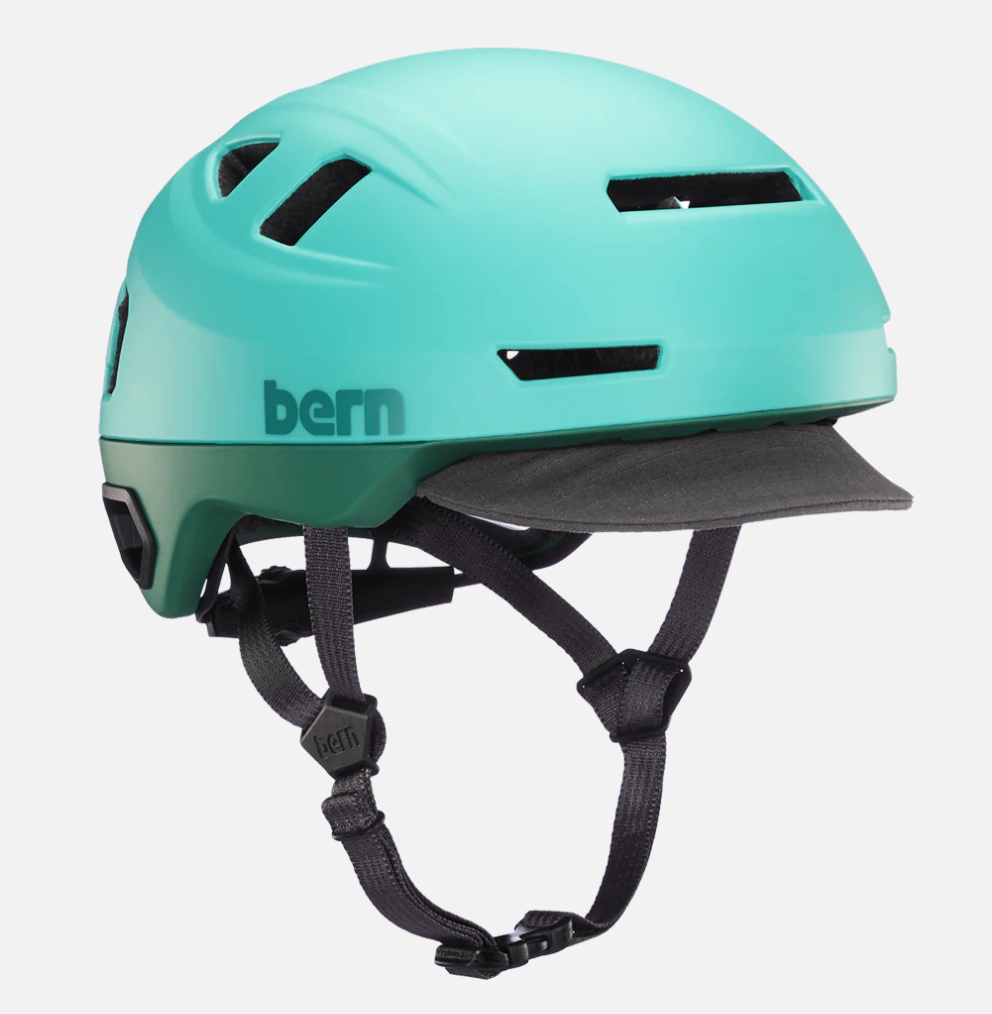
- Strengths: The Hudson is tailored for urban riders, with integrated LED lights for visibility, MIPS for safety, and a stylish, low-profile design. It also meets additional safety standards for e-bike use.
- Weaknesses: Its urban design means it might not be the best choice for more aggressive road or trail riding.
- Customer Feedback:
"I bought this helmet to replace a 13 year old Bern helmet that had taken 3ish decent impacts. When it showed up I was really shocked at how bulbous it looked both in the box and on my head but it is incredibly light weight, has a built in light and is easily adjusted. I went with the MIPS as a rider who enjoys his brain this made sense. Been has yet to let me down, I’m excited to continue to be part of the family."
"This helmet looks and feels great. Fits perfectly using the adjusting feature. The removable brim is a fantastic idea. Not all days are sunny, so to be able to remove brim quickly and easily opens viewing area. The shell seems very well made. Hopefully I’ll never know if it provides superior protection, but I do feel that it will, and that gives me peace of mind."
5) Kids' Helmet: Nutcase Little Nutty Vikki King Gloss
- Strengths: The Little Nutty is a hit with kids and parents alike, offering fun designs, MIPS protection, and a no-pinch magnetic buckle. It's designed to grow with the child, featuring an adjustable dial fit system.
- Weaknesses: While it's packed with features, its price point is higher than some other kids' helmets on the market.
- Customer Feedback:
"I feel very safe having my son use this helmet. I also see so many of the neighborhood kids use this as well, which is a testament to the brand."
"LOVE this and all my nutcase helmets! Feels so great I kinda want to wear it around the house... not even kidding."
Remember, the best helmet is one that fits well, suits your riding style, and includes safety features that protect you on the road or trail. Whether you're commuting through city streets, tearing up mountain bike trails, or logging miles on the road, there's a helmet designed to meet your needs and keep you safe.
Also, keep in mind that your bike helmet is different than motorcycle helmets. They are rated to a higher standard to account for the different speed and safety measures.
Affordable Bicycle Helmets
To provide valuable insights on affordable bicycle helmets that don't skimp on quality or safety, let's focus on three distinct, well-regarded bike helmets, that cater to various needs and preferences:
1) For the Casual Rider: Schwinn Thrasher Helmet
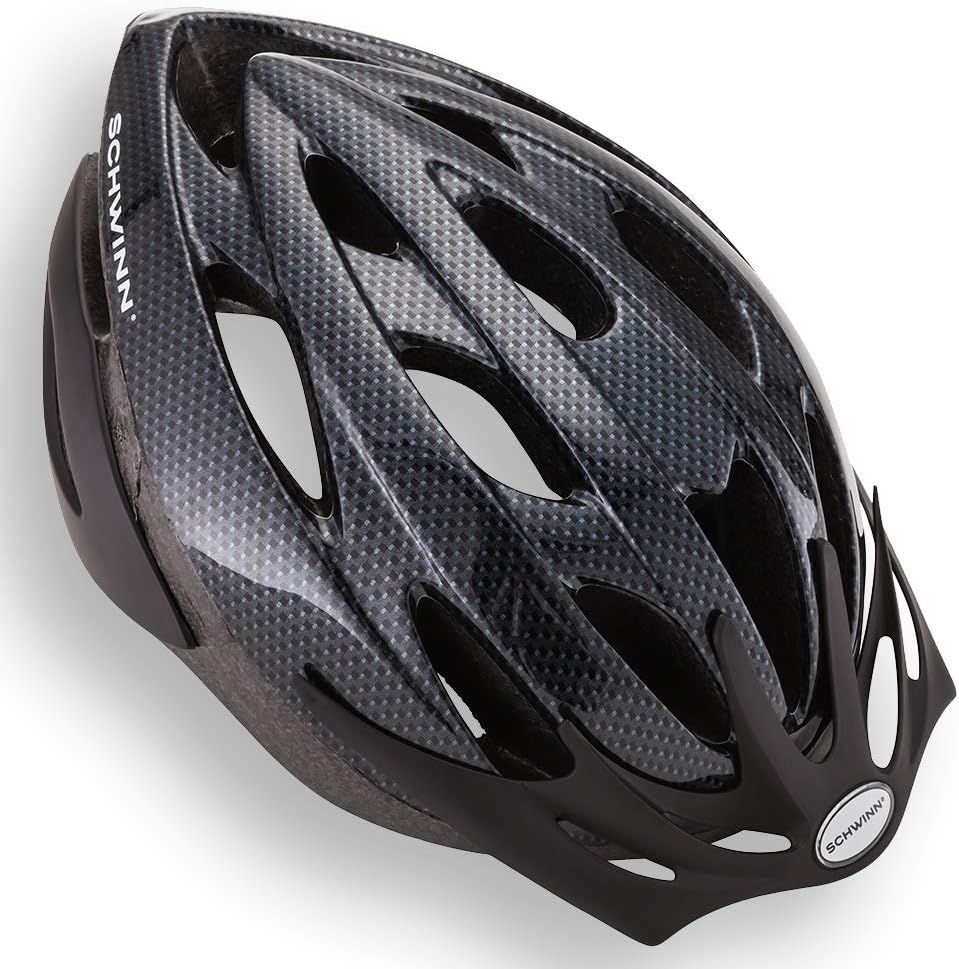
The Schwinn Thrasher is a versatile, budget-friendly option that doesn't compromise on safety. It's a great fit for casual riders and weekend warriors.
- Key Features: This helmet boasts multiple air vents for optimal ventilation, a dial-adjustable fit for comfort, and a removable visor to adapt to different riding conditions.
- Price Range: Often found in the range of $29.99 - $49.99, making it an excellent value for casual cycling.
- Why It's a Great Deal: Despite its low price, the Thrasher meets standard safety certifications and offers features typically found in more expensive helmets.
2) For the Commuter: Bell Local Qualifier Helmet
The Bell Local blends classic skate style with modern cycling and bike helmet features ventilation, making it ideal for urban commuters who prioritize both safety and style.
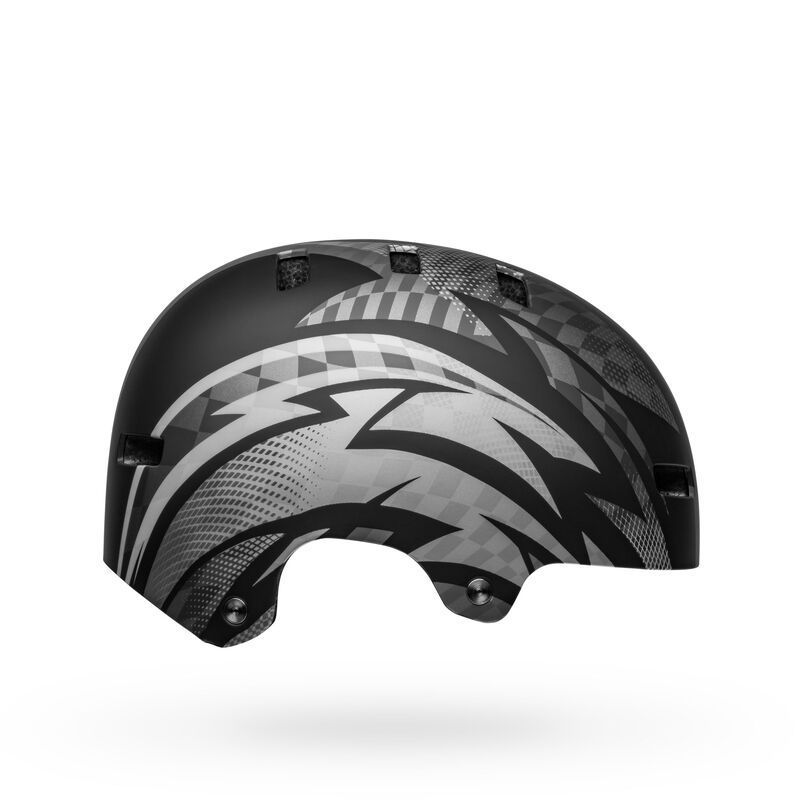
- Key Features: It features an adjustable fit system, a durable ABS shell, and ten vents for cooling. Its design allows for a comfortable fit even with hats or beanies underneath, a common need for commuters.
- Price Range: The price range is currently not mentioned on the website, However, they are offering 20% OFF on selected helmets with robust protection for daily commutes without breaking the bank.
- Why It's a Great Deal: It's a stylish, multipurpose helmet that provides the protection commuters need, with the versatility to be used for other activities like skateboarding or rollerblading.
3) For Children: Giro Scamp Helmet
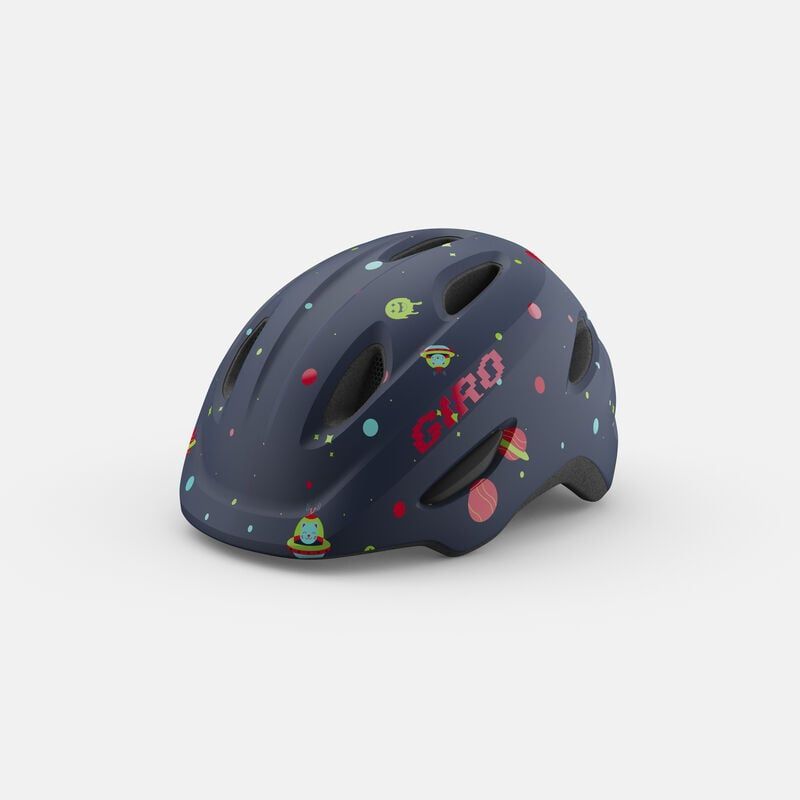
The Giro Scamp is designed with young riders in mind, offering high-quality protection in a child-friendly package.
- Key Features: This helmet includes a built-in visor, pinch-guard buckle, and an easy-to-adjust fit system. It also comes in a range of fun colors and designs to appeal to kids.
- Price Range: Typically priced around $50, it's an investment in your child's safety and comfort while riding.
- Why It's a Great Deal: The Scamp not only meets rigorous safety standards but is also designed to grow with your child, thanks to its adjustable fit system, making it a long-lasting choice.
Finding Deals and Promotions:
Prices of helmets like the Specialized S-Works Evade II, Fox Racing Speedframe Pro, and Thousand Heritage Helmet can vary, so it's advisable to look for discounts or special offers from online retailers, local bike shops, and manufacturers. End-of-season and Black Friday sales are great opportunities for deals.
Affordable options like the Schwinn Thrasher, Bell Local, and Giro Scamp prove that you can find a helmet that offers safety, comfort, and style without overspending. The key is to choose a helmet that fits well, meets safety standards, and matches your cycling needs, whether for casual rides, daily commutes, or children's safety.
Bike Helmet Reviews and Recommendations
In this comprehensive review section, we'll delve into three standout bicycle helmets, each catering to different facets of the cycling world: the road warrior, the trail enthusiast, and the urban commuter. Our analysis covers comfort, durability, safety certifications, and overall customer satisfaction, providing you with well-rounded recommendations for your next ride.
1) Specialized S-Works Evade II – The Road Warrior's Choice
Comfort and Fit: The S-Works Evade II is lauded for its exceptional comfort, thanks to its Mindset HairPort II micro-dial fit system that offers precise adjustments. Coupled with 4th Dimension Cooling, it ensures a snug fit while keeping your head cool during intense rides.
Durability: Built with a tough polycarbonate outer shell and an expanded polystyrene foam inner liner, this helmet is designed to withstand the rigors of high-speed road cycling without compromising on weight or aerodynamics.
Safety: It not only meets but exceeds safety standards with its ANGi crash sensor and MIPS technology, providing riders with an added layer of protection against rotational forces in the event of an impact.
Customer Satisfaction: Users consistently praise its lightweight feel and aerodynamic design, noting significant improvements in speed and cooling. Some mention the premium price, but most find the investment worthwhile for the performance gains.
2) Fox Racing Speedframe Pro – The Trail Enthusiast's Dream
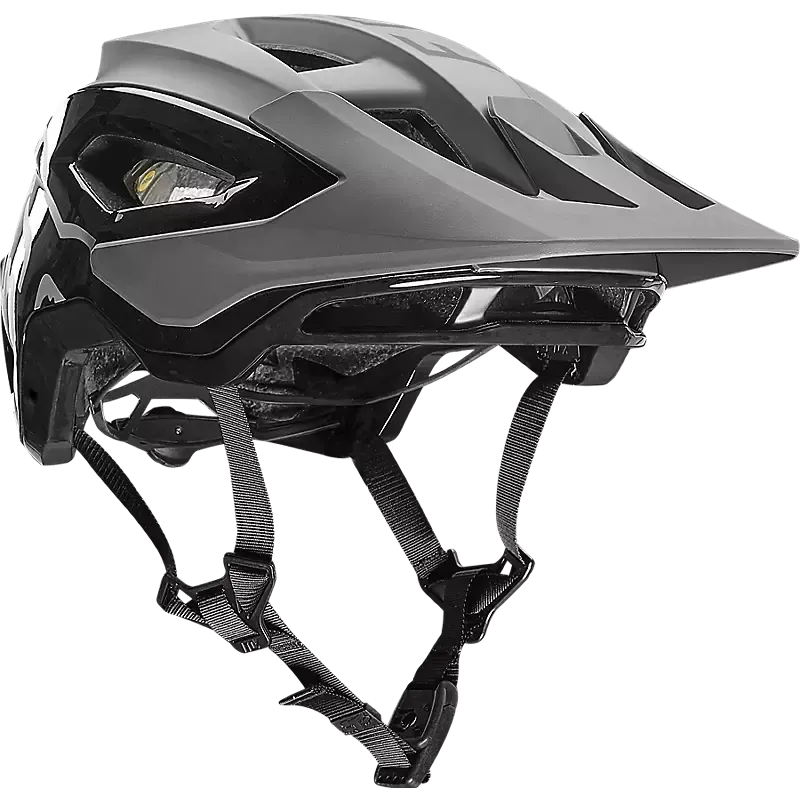
Comfort and Fit: The Speedframe Pro is renowned for its comfort on the trails, featuring a 360-degree fit system for a secure, customizable fit. Its moisture-wicking liner and optimized venting keep you comfortable even on the most challenging rides.
Durability: This helmet is ready to tackle rough terrain with its Varizorb EPS liner and an injection-molded shell, providing robust protection without adding unnecessary bulk.
Safety: Equipped with MIPS and dual-density EPS foam, the Speedframe Pro excels in reducing rotational and linear impact forces, ensuring top-tier protection. It's certified to CPSC and EN 1078 standards, offering peace of mind on rugged trails.
Customer Satisfaction: Mountain bikers rave about its balance of protection, ventilation, and comfort. The inclusion of a goggle-compatible, adjustable visor is a frequently highlighted feature, making it a favorite among enduro riders.
3) Explore Thousand Heritage Helmet – The Urban Commuter's Companion
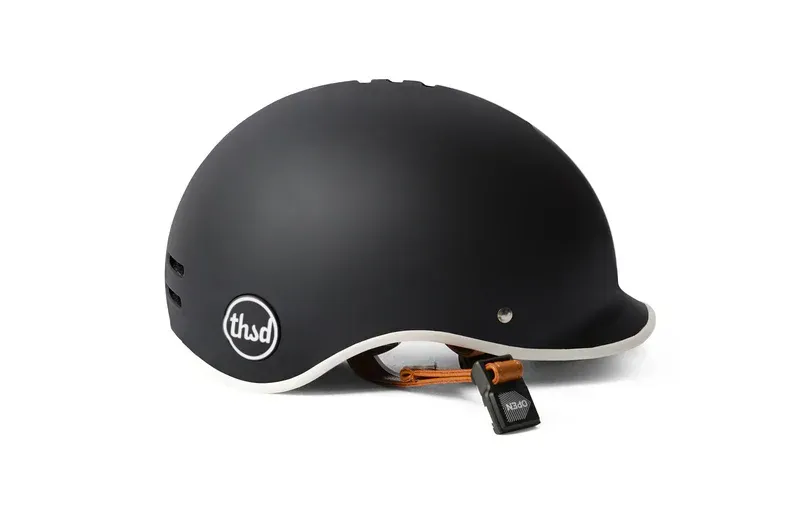
Comfort and Fit: The Explore Thousand Heritage combines style with comfort. Its vegan leather straps and dial-adjust fit system provide a plush, secure fit, while multiple vents ensure efficient airflow, keeping urban riders cool in the city hustle.
Durability: With a tough ABS shell and a lightweight EPS liner, this helmet is built to endure the daily demands of city riding, offering durability without sacrificing style.
Safety: This helmet meets CPSC and EN 1078 safety standards, ensuring comprehensive protection. The unique PopLock feature allows riders to securely lock their helmet with their bike, adding a layer of convenience and theft protection.
Customer Satisfaction: Commuters love Heritage for its retro look, comfortable fit, and thoughtful features like the secret PopLock. While some desire more color options, the consensus is that it's an excellent blend of form, function, and safety for city riding.
Bike Helmet Maintenance and Care
Regular maintenance of your bicycle helmet, including cleaning, proper storage, and timely replacement, is key to ensuring its longevity and effectiveness in providing protection.
1) Cleaning Your Helmet:
- Surface Cleaning: Use mild soap and water to clean the helmet's outer shell. Avoid harsh chemicals or solvents, as they can degrade the helmet materials. For best bike helmet care, use a soft cloth or sponge to gently remove dirt and sweat.
- Interior Pads: Most helmets have removable pads that can be hand-washed with mild detergent. Allow them to air dry completely before reinserting them into the helmet.
- Straps: Wipe down the chin straps with a damp cloth and mild soap. Ensure they're fully dry before using the helmet again.
2) Storing Your Helmet:
- Cool, Dry Place: Store your helmet in a cool, dry environment away from direct sunlight. UV rays can weaken the helmet's materials over time, reducing its protective capabilities.
- Avoid Compression: Don't hang your helmet on a bike hook by the straps, as this can deform the foam. Instead, place it on a flat surface.
3) When to Replace Your Helmet:
- After a Crash: Always replace your helmet after an impact, even if there's no visible damage. The foam inside is designed for one-time use, and its ability to absorb another impact is compromised.
- Wear and Tear: Look for signs of wear, such as cracks in the foam, fraying straps, or faded colors, which indicate it's time for a new helmet.
- Every 3-5 Years: Even if your helmet hasn't been in a crash, it should be replaced every 3-5 years due to natural wear and degradation of materials.
In conclusion, finding the perfect bicycle helmet hinges on understanding your specific needs as a cyclist. Your ideal helmet should seamlessly blend protection, comfort, and style. With the rapid advancements in helmet design and technology, cyclists now have access to an unprecedented range of choices tailored to every riding style.
Whether you're a commuter, road warrior, or trail enthusiast, choosing a helmet is not just about compliance but about prioritizing your safety and well-being. So, ride confidently, secure in the knowledge that your helmet has you covered on every adventure. Stay safe and enjoy the ride!
Helmet FAQs
Q: How Do I Know if a Bike Helmet Fits Properly?
A: A properly fitting bicycle helmet should sit level and snug on your head without tilting forward or backward. The side straps should form a “V” shape just below your ears, and the chin strap should be tight enough that only one or two fingers can fit between the strap and your chin. A secure fit is essential for maximum protection.
Q: How Long Do Bicycle Helmets Last?
A:
Most bike helmets should be replaced every 3 to 5 years, depending on how often you ride and how much sun, sweat, or weather exposure the helmet endures. If your helmet has been in a crash—even if there’s no visible damage—it should be replaced immediately. Impacts can compromise the helmet’s ability to protect you.
Q: What’s the Best Way to Clean a Bike Helmet?
A: To clean your bicycle helmet, use mild soap and lukewarm water to wipe down the outer shell with a soft cloth. Hand wash the interior pads with gentle detergent, then air dry them completely. Straps can be cleaned with a damp cloth and a small amount of soap to remove sweat and grime. Avoid harsh chemicals that could weaken materials.
Q: Is It Safe to Buy a Used Bicycle Helmet?
A: Buying a used bike helmet is not recommended. You can’t be sure whether a second-hand helmet has been in a crash or has hidden damage. Even if it looks fine, internal protective materials may be compromised. For your safety, always purchase a new helmet with a known history and intact protective features.
Ride Protected. Ride Safe with Bike Legal
At Bike Legal, we are cyclists representing injured cyclists. As dedicated bicycle accident attorneys, we bring unmatched expertise in bicycle accident law and a deep understanding of the cycling community. We fight for justice and fair compensation for injured riders.
Beyond legal representation, we’re passionate advocates for cyclist safety, education, and responsible road sharing.
If you have been injured in a bicycle accident or just have questions, we can help.
📞 Call 877-BIKE LEGAL (877-245-3534) for a FREE Consultation.
